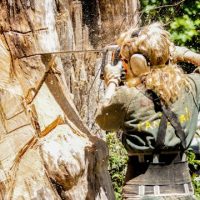Tree surgery is both an art and a science, demanding skill, precision, and the right tools to maintain trees’ health and beauty. tree surgeons, or arborists, work in environments that range from residential backyards to dense urban landscapes, wielding a unique toolkit. Here’s a deep dive into the essential tools of the trade that enable these experts to tackle each challenge with safety, precision, and efficiency.
1. Chainsaws: Power and Precision
At the heart of a tree surgeon’s toolkit is the chainsaw, which must balance power and maneuverability. Chainsaws come in various sizes, from lightweight models suited for pruning small branches to heavy-duty models designed for felling large trees. Arborists frequently choose specific brands and models based on the reliability of the engine, ease of handling, and the saw’s balance.
2. Hand Saws and Pruning Tools: The Surgeon’s Scalpel
For precise cuts and more delicate tasks, tree surgeons rely on hand saws. Pruning saws are curved to offer a cleaner cut through smaller branches and dense foliage. Pole pruners and loppers allow them to reach high branches without climbing, perfect for trimming branches that may be weak or pose a hazard.
3. Rope and Harness Systems: Staying Secure at Great Heights
Given the towering nature of their work, tree surgeons often rely on advanced climbing systems. Climbing harnesses and ropes form the backbone of safe tree ascension and descent, especially when working on large trees or in crowded urban spaces. These systems must be rated for the weight and dynamic forces a tree surgeon might encounter, ensuring both comfort and reliability.
4. Wood Chippers: Efficient Disposal of Waste
After branches or entire trees are removed, the next challenge is managing the waste. Wood chippers make disposal efficient by breaking down branches and wood into mulch or manageable chips. These machines come in various sizes, from small, towable units to larger models with a higher horsepower that can handle large logs.
5. Stump Grinders: Clearing the Root of the Problem
After felling a tree, the remaining stump can be unsightly and obstructive. Stump grinders are specialized machines designed to shred the stump into wood chips. They come in various sizes and can range from handheld units for small stumps to heavy-duty grinders for larger ones.
6. Tree Augers and Soil Drills: Digging for Stability
When replanting trees or stabilizing the soil, tree augers and soil drills play a critical role. These tools are essential for digging precise holes for saplings or even aerating the ground around the roots of mature trees. By loosening compacted soil, tree surgeons can enhance root oxygenation and water drainage, creating a healthier environment for the tree.
7. Measuring Tools: Precision in Practice
Tree surgeons must assess trees with great accuracy, especially when diagnosing diseases or assessing structural integrity. Laser rangefinders help gauge tree height and positioning, while diameter tapes are used to measure trunk girth. These instruments ensure that every cut, removal, or treatment is calculated and measured for the tree’s optimal health and the property’s safety.
Conclusion
With a robust arsenal of tools and equipment, tree surgeons can safely and effectively manage trees in any setting. From the roaring power of chainsaws to the precision of hand tools, each item in an arborist’s toolkit is integral to maintaining the balance between human needs and the natural environment.



